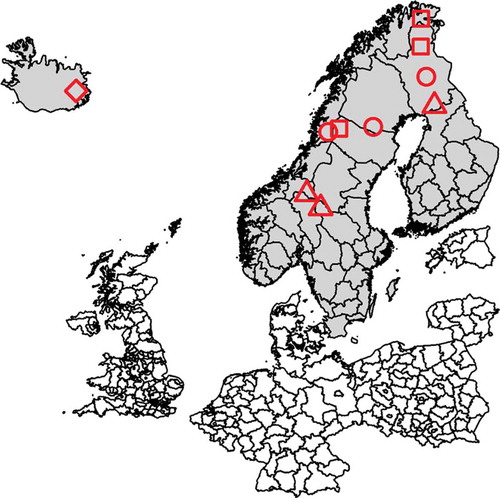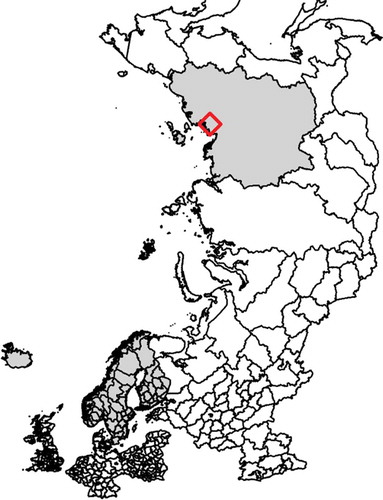Figures & data
Table 1. Details of the 520 serum samples obtained from Eurasian tundra reindeer (Rangifer t. tarandus), including both calves (≤1 year) and adult animals (>1 year) from Finland, Norway, Sweden, Iceland and Russian Federation. Sampling was performed during two consecutive years. Samples from Finland, Norway and Sweden were taken from three geographically separated herds in each country.
Figure 1. (a) Map showing the sampling sites in Finland, Sweden and Norway (reindeer abattoirs with catchment areas selected to reflect herding conditions at different locations, denoted ‘A’ (■), ‘B’ (●) and ‘C’ (▲) and the sampling sites in Iceland (♦). (b) Map showing the sampling site in Ust–Yanks District, northern Yakutia, Russian Federation (♦).

Table 2. Results of testing samples from Eurasian tundra reindeer (Rangifer t. tarandus) for anti-pestivirus antibodies in a commercial blocking ELISA: number of samples classified as positive, negative and doubtful (undetermined), and seroprevalence with 95% confidence interval (CI) per country and in sampling year 1 and 2. Doubtful results were not included in calculation of seroprevalence.
Table 3. Results of testing samples from Eurasian tundra reindeer (Rangifer t. tarandus) for anti-pestivirus antibodies in a commercial blocking ELISA, divided into age groups ‘calves’ (≤1 year) and ‘adults’ (>1 year), shown as number of animals classified as positive out of the total number of animals from each sampling site, and as a percentage.
Table 4. Results of testing a subset of serum samples from Eurasian tundra reindeer (Rangfer t. tarandus) for anti-pestivirus antibodies in a virus neutralisation test (VNT) in herds with ELISA-positive or doubtful animals: presence of neutralising antibodies to pestivirus and titre for two animals (a and b) from one herd as determined in the VNT, compared with competition percentages from the blocking ELISA (22.7% positive, 4.6% doubtful and 72.7% negative).

